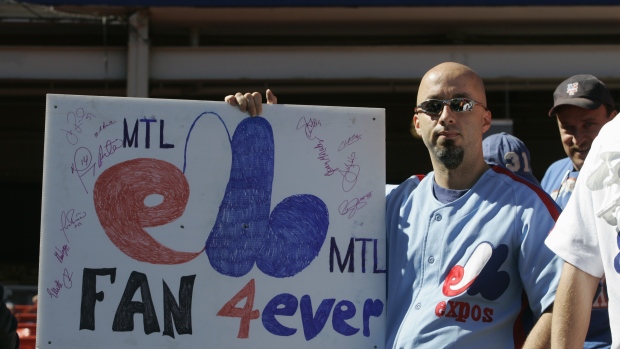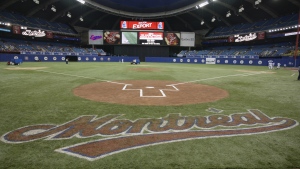Oct 31, 2016
The past and future: Bronfman and baseball
Former Expos majority owner Charles Bronfman has written Distilled - a new book outlining the billionaire businessman's efforts to bring Major League Baseball to Canada. And what does he think of MLB returning to Montreal?
, TSN.ca Staff

Charles Bronfman is not getting any younger and time was not on his side when it came to putting pen to paper.
“I’m 85 and I don’t know when the Grim Reaper is going to come around,” Bronfman told TSN.ca about writing his book Distilled, about the billionaire businessman's efforts to bring Major League Baseball to Canada. “I thought I had something to say, particularly to my grandchildren.
"It seemed like a good time and, also, I had the time to do it. Oftentimes, one doesn’t. You can’t do these things rushed."
Distilled isn’t the Seagram heir's first book, but it is his first foray into self-examination. And for the Officer of the Order of Canada, writing about personal matters wasn’t a heavy task.
“I didn’t find this a particularly onerous or difficult process,” Bronfman explained. “It wasn’t when I talked about particularly difficult things, for instance, my childhood when I thought I was a wimp.
"It was more factual for me than emotional.”
Part of that was because Bronfman has engaged in constant introspection over his lifetime. So when confronting unpleasantness from his past through the writing process, it wasn’t as if he hadn’t contemplated it before.
“I don’t know about your own youth or where you were or where you think you’re going, but you mull these things over, or at least I did,” he explained. “I was saying to myself, ‘How come you weren’t good in school?’ or this, that or the other thing about yourself and your family.
"So I had gone through that so many times and I was happy to actually put it down on paper.”
While Bronfman writes of growing up wealthy, the expectations that arose from his upbringing, the demise of the Seagrams company in 1971 and both professional and familial conflicts, of particular interest to sports fans are his tales of the Montreal Expos.
For Bronfman, there are two indelible memories of the club he owned until 1990 – and they both came in the team’s inaugural season.
“Actually, it was the two opening days,” said Bronfman. “In New York [on April 8, 1969 – the team’s first ever game], when 40-odd thousand Americans stood up for our national anthem and [contralto] Maureen Forrester sang it and the College militaire royal [du Canada] band was there on the field at Shea Stadium.
“I remember standing next to [Montreal mayor] Jean Drapeau with the noise of the planes flying overhead and he said, ‘How can they allow planes?’ That was a wonderful day and, of course, winning the game by the tremendous score of 11-10 was very nice.”
Equally enjoyable for Bronfman was the club’s first home opener, a week later at Jarry Park in Montreal. The previous winter – under threat of losing the franchise to Buffalo – there was a wild scramble to find a suitable park for the team to play in. Expanded to a 30,000-seat capacity, the stadium in Villeray (in the north end of the city) would serve as the team’s from 1969 to 1976, despite its many quirks including a preexisting swimming pool just over the right field wall.
Bronfman remembers that first game fondly.
“It was sensational,” said Bronfman of the team’s 8-7 win. “It was a beautiful, warm day. They finally finished putting seats in the stands an hour before game time. The outfield was a mess. Curt Flood of the St. Louis Cardinals, who we were playing that day, said afterwards that it was so terrible, he didn’t know which way the ball was going to go and you could injure yourself.”
Stadium issues would go on to become a hallmark of the Expos franchise.
“There were a lot of sort of crazy things that happened,” Bronfman recalled.
As part of the league awarding a franchise to Montreal, a domed stadium was to be in place by 1972. In fact, that was also one of the caveats in place for Bronfman’s ownership group to initially get on board with the franchise. Getting one built would prove to be easier said than done.
“When I agreed to join and the others agreed to join at the beginning to become partners in the Expos, I had said to [Montreal city councilor] Gerry Snyder, who was Drapeau’s vice chairman of the executive committee, that we’d be in provided that we had a covered stadium,” said Bronfman. “Sure enough, Drapeau wrote a letter to the National League saying that there would be a covered stadium.”
As it turns out, an executive order from city council that was to guarantee the stadium wasn’t as executive an order as Bronfman and the Expos were led to believe.
“One day, I went to see [another councilor] Mr. [Lucien] Saulnier, who was the chairman of the executive committee and the moneybags of the administration,” Bronfman continued. “And his two favourite words were ‘definitely not.’ He said, ‘Why are you talking about a covered stadium?’ I told him that Drapeau wrote a letter promising a covered stadium.
“He said, ‘That’s very nice he wrote a letter. Well, I didn’t write a letter and you could’ve written a letter, too.’ I asked what he was talking about and he said, ‘You please show me in the minutes of the executive committee or the city council where he was authorized to write that letter.’ I said, oh my God, no. So Drapeau had done this with no authorization.”
The team would eventually move into the Olympic Stadium in time for the 1977 season, but not before a few more bumps in the road.
Firstly, there was the controversy caused by Bronfman himself. With the threat of Rene Levesque’s separatist Parti Québécois forming the government in the 1976 provincial election looming, Bronfman told a local reporter, "Under normal circumstances, I'd sell [the team]. But who's gonna pay in a separate Quebec? So I guess I have to take it with me."
Levesque was elected, but the team remained.
“Once I said that, I was very emotional, but I didn’t go,” said Bronfman. “The team didn’t go and we tried to win. It was very simple. Of course, it was still in the ‘70s and then we got into the Olympic Stadium and it gave us – pardon the expression – a new lease on life.”
Since it was the Expos and nothing came easy, such was the case with the opening of the stadium. The Expos ownership group didn’t get to see the finished product ahead of time. And Bronfman wasn’t exactly prepared for what he was seeing.
“We had the privilege of seeing the configuration of the stadium at exactly the same time as the media did,” Bronfman explained. “We had no idea and, oh my God, it was awful.
“I remember walking into the stadium with John McHale, our president, and Harry Reneault, our secretary-treasurer, and I looked at both of them and I looked around this huge monster. I zeroed in on one thing and I said, ‘Oh my God, those yellow seats.’ John said, ‘Well, you don’t like the colour?’ and I said, ‘John, when people aren’t sitting in the those seats – which were down on the ground level, the lowest level of tiers – the yellow seats are going to show up a helluva lot more than the people.’ Oh, it was tragic.”
A winning team quickly made up for the aesthetic failings.
“We had those great years from ’79 to ’82,” said Bronfman. “We won more games than anybody else in the National League, but never made the World Series. It’s the one regret I have. ‘Blue Monday,’ [The fifth and deciding game of the 1981 National League Championship Series won 2-1 by the Los Angeles Dodgers over the Expos on a ninth-inning Rick Monday home run] I’ll never forget it.”
Bronfman thought the team would capture that elusive World Series in 1987. With the likes of Tim Raines, Andres Galarraga and Tim Wallach entering their primes and the additions of free agents Dennis “El Presidente” Martinez and Pascual Perez, the Expos were a formidable club. Front-office scandal, though, would end up overshadowing the team on the field (they finished with 91 wins and three games behind the Cardinals in the NL East). While Bronfman is quick to heap praise upon then-GM Murray Cook, it was Cook himself who was author of his own demise that year.
“Unfortunately, he was playing with somebody’s wife and we had to make a decision,” remembered Bronfman.
That somebody was, in fact, club president, CEO and future owner, Claude Brochu. Cook was let go in August of that year, in the midst of a pennant race.
“We would have won that year because he, for instance, found people who had been druggies, alcoholics and bad seeds, brought them in and made them feel at home,” said Bronfman. “They not only survived, but they thrived. It was a lot of fun.”
Bronfman himself would be gone only three years later, selling the team to Brochu in 1990. Though the closing date of the sale was only weeks before the calendar turned to 1991, Bronfman says the team stopped feeling like his well earlier than that. Citing the seemingly frivolous spending of other teams and labour strife on the horizon (Bronfman would be proved prescient only a few years later when a strike wiped out the 1994 World Series), the final straw for Bronfman became dwindling local interest in the team.
“Our attendance went down,” said Bronfman. “We had these young, terrific players and the problem was nobody was coming out to see them. So when we should have had 20,000 people, at least, in the stands we had seven [thousand]. It was very, very debilitating.”
Bronfman left Montreal in 1996, moving to New York City. By the time the Expos left for Washington, D.C. after the 2004 season, they were long out of Bronfman’s mind. Still, he did feel a sense of sadness in knowing the team was gone from his hometown.
“I did not know [Jeffrey] Loria – I’ve met him, but it was a shame the way it all happened,” he said. “But you can talk about the stadium – the stadium was a killer at the end of the day.”

And a stadium is one of the main sticking points over whether or not the city of Montreal will ever see the return of baseball. Though the Toronto Blue Jays have hosted spring training exhibition games at the Big O, it’s not a suitable ground for every-day usage. A new park – among other factors – would be a necessity for baseball to come back to the city. And if that were to happen, there would almost certainly be funding from municipal, provincial and federal levels required.
Bronfman is skeptical about a homecoming for the Expos actually happening.
It can, but it’s a question of if it will,” Bronfman said. “It could come back two ways: expansion, with a very big price tag on it, or a team relocating. It all depends on how badly governments think that they need a Major League Baseball team. And a stadium can do other things than just baseball.”
Doing other things than just baseball is what Bronfman spent the majority of his adult life doing.
Distilled is the record of that time.
--
Distilled is available now.

